
Waikino
Encyclopedia
Waikino is a small town situated in the North Island
of New Zealand
nestled in the Southern end of a gorge alongside the Ohinemuri River
, between Waihi
and the Karangahake Gorge
. The Waikino district lies at the base of the ecologically sensitive Coromandel Peninsula
with its vast tracts of lush subtropical rainforests, steep ravines and fast moving rivers and streams. "Waikino" is Māori and means "water in a gorge'
- Bay of Plenty
district with the 1897 construction of the Victoria Battery on the edge of what was a busy town supporting the expansive local Mining industry. Waikinos Victoria Battery processed ore from the large Martha Mine in Waihi
. The Victoria Battery was then New Zealand's largest Industrial Complex, besides processing ore, it supported carpenters shops, a sawmill and a foundry. With 200 stamps, the Battery was the largest quartz crushing plant for gold extraction in Australasia and was capable of crushing over 812 tonnes of ore each day to the consistency of sand. The loud thumping sounds of crushing rock could be heard 10 klms away.
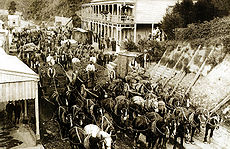 Up the scenic Waitekauri road 5 km behind Waikino, once existed the mining town of Waitekauri, near Golden Cross. Waitekauri is no longer there today because the town was demolished at the end of that era’s gold rush
Up the scenic Waitekauri road 5 km behind Waikino, once existed the mining town of Waitekauri, near Golden Cross. Waitekauri is no longer there today because the town was demolished at the end of that era’s gold rush
, consequently the village reverted to farmland. The local Waitekauri watering hole, the historic two storied “Golden Cross Hotel”, was literally transported to Waihi
where it stands proud today as a reminder of day’s gone by.
On October 19 1923 the Waikino school shooting occurred at Waikino School, which claimed the lives of two students and remains New Zealand's deadliest - and only - school shooting. The gunman, John Christopher Higgins, was later convicted of murder and initially sentanced to death but that was commuted to life imprisonment, Higgins later had his conviction quashed by reason of insanity.
When Gold became uneconomic to mine after World War Two, Waikino residents lost their economic base and the town reverted into a sleepy little village predominantly inhabited by retirees from the old era. However, the small retail business community in Waikinos main street endured till the late fifties. When Tom and Nell Buchanan finally closed the doors to the local general store and haberdashery and retired up on the hill behind the village, this signalled the end of an era.
The 1970s heralded an influx of new people to Waikino, drawn by cheap housing and magnificent scenery. The Counterculture
had arrived in town and set about transforming Waikino into a bustling centre for hippies and crafts people to gravitate towards. These counterculture
folks purchased many of the old houses in the village which had been neglected over time, and even converting some of these into small craft workshops and outlets from where they sold their wares locally and around the nation. Waikinos main highway retail shops were back in business.
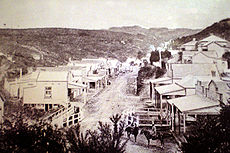 The main highway (State Highway 2
The main highway (State Highway 2
) retail shops which traversed the beautiful Ohinemuri river before it plunged into the Karangahake Gorge
had its old shops and Lodge Hall refurbished and reopened from this influx of young alternative lifestyle
people moving in their droves away from the big city chaos. Social revolution was in the air, this was the roaring seventies and for many a young persons the flow from big city living towards a more country oriented sustainable lifestyles in rural New Zealand was the name of the game. Overnight, flourishing cottage industry craft
s and health food
outlets grew around Waikino, servicing the local village and Coromandel
. Once again, the former ghost town having being closed down for some time became the focal meeting point of the community. The business strip reinvigorated, people returned to town to do business. Hundreds of tourists, drawn by the quirky hippie
atmosphere, stopped at Waikinos main highway retail outlets every week to try out healthy home made foods at the tea rooms, and to purchase local made Arts and crafts
from the various hippy shops. Some stopped to simply chill out taking in the scenic atmosphere, watching the chilly Ohinumeri river flow into the breathtaking Karangahake Gorge
.
January 1977 saw the community supported Waikino music festival
of rock, blues and culture, held on Bicknels farm up the Waitawheta Valley. This festival
event was run by the Nambassa
group who were originally based in the Waikino village, prior to their move to Waihi
. Proceeds from this event purchased a winters supply of fuel for the aged residents of the village and towards the construction of a new post office after the 1981 flood.

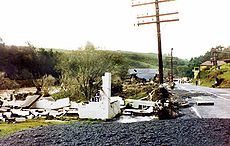 The main highway shops came to a devastating end in the great Ohinemuri river floods of 1981. A huge torrent of water literally picked up the Waikino business district and many homes, and washed them downstream through the Karangahake Gorge
The main highway shops came to a devastating end in the great Ohinemuri river floods of 1981. A huge torrent of water literally picked up the Waikino business district and many homes, and washed them downstream through the Karangahake Gorge
. All that was salvageable was the Waikino Hotel and the local community hall, both of which remain operational today.
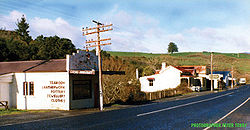 A new Post Office
A new Post Office
was later built on higher ground with funds raised by the community. Initially the National Government deemed a new community Post Office uneconomical, and so decided not to replace one of the towns focal community service which was dependent upon by the large aged population to cash their weekly pension cheques. This unwelcome decision raising an uproar with the locals, many of whom became overnight activists. This heralded the establishment of the "Waikino Action committee" whom lobbied Government and the wider community to have a new community Post Office constructed. After a bitter campaign the Government reneged and agreed to build a Post office providing the community footed much of the bill- which it did. After the postal services were privatised under Rogernomics
in the 1990s this postal service was terminated permanently.
Waikino also has its own Primary School which even caters for children from as far as Waihi
with a daily bus service. The school provides for Year 1 to 6 students and boasts one computer per two students ratio. http://www.waikino.school.nz/
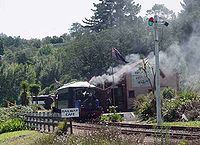 Tourism
Tourism
and cottage industries are Waikino's primary revenue sources today. Numerous organised tours and walks around the old mining facilities and old rail tunnels, and around beautiful native bush which surround waterfalls and scenic valleys, are available. There is also a community sponsored heritage railway from the Waikino station café to Waihi, the Goldfields Railway
. This line used to be part of the East Coast Main Trunk Railway and opened in November 1905, but in 1978, a deviation to the south opened and made it redundant. The Goldfields Railway successfully saved the 6 km of track between Waihi and Waikino and is now a popular tourist attraction, running trains daily with preserved steam locomotive
s and diesel locomotive
s providing motive power.
North Island
The North Island is one of the two main islands of New Zealand, separated from the much less populous South Island by Cook Strait. The island is in area, making it the world's 14th-largest island...
of New Zealand
New Zealand
New Zealand is an island country in the south-western Pacific Ocean comprising two main landmasses and numerous smaller islands. The country is situated some east of Australia across the Tasman Sea, and roughly south of the Pacific island nations of New Caledonia, Fiji, and Tonga...
nestled in the Southern end of a gorge alongside the Ohinemuri River
Ohinemuri River
The Ohinemuri River is located in the north of New Zealand's North Island.The river source is north-east of the town of Waihi, close to the shore of the Bay of Plenty, but flows west rather than into the bay. It runs through the steep-sided Karangahake Gorge, forming a break between the Coromandel...
, between Waihi
Waihi
Waihi is a town in Hauraki District in the North Island of New Zealand, especially notable for its history as a gold mine town. It had a population of 4,503 at the 2006 census....
and the Karangahake Gorge
Karangahake Gorge
The Karangahake Gorge lies between the Coromandel and Kaimai ranges, at the southern end of the Coromandel Peninsula in New Zealand's North Island. A sharply winding canyon, it was formed by the Ohinemuri River. State Highway 2 passes through this gorge between the towns of Paeroa, Waikino and Waihi...
. The Waikino district lies at the base of the ecologically sensitive Coromandel Peninsula
Coromandel Peninsula
The Coromandel Peninsula lies in the North Island of New Zealand. It is part of the Waikato Region and Thames-Coromandel District and extends 85 kilometres north from the western end of the Bay of Plenty, forming a natural barrier to protect the Hauraki Gulf and the Firth of Thames in the west...
with its vast tracts of lush subtropical rainforests, steep ravines and fast moving rivers and streams. "Waikino" is Māori and means "water in a gorge'
History
Gold mining around Waikino has a history dating back to early colonisation of New Zealand. Waikino was the focal point of Gold mining in the WaikatoWaikato
The Waikato Region is a local government region of the upper North Island of New Zealand. It covers the Waikato, Hauraki, Coromandel Peninsula, the northern King Country, much of the Taupo District, and parts of Rotorua District...
- Bay of Plenty
Bay of Plenty
The Bay of Plenty , often abbreviated to BOP, is a region in the North Island of New Zealand situated around the body of water of the same name...
district with the 1897 construction of the Victoria Battery on the edge of what was a busy town supporting the expansive local Mining industry. Waikinos Victoria Battery processed ore from the large Martha Mine in Waihi
Waihi
Waihi is a town in Hauraki District in the North Island of New Zealand, especially notable for its history as a gold mine town. It had a population of 4,503 at the 2006 census....
. The Victoria Battery was then New Zealand's largest Industrial Complex, besides processing ore, it supported carpenters shops, a sawmill and a foundry. With 200 stamps, the Battery was the largest quartz crushing plant for gold extraction in Australasia and was capable of crushing over 812 tonnes of ore each day to the consistency of sand. The loud thumping sounds of crushing rock could be heard 10 klms away.

Gold rush
A gold rush is a period of feverish migration of workers to an area that has had a dramatic discovery of gold. Major gold rushes took place in the 19th century in Australia, Brazil, Canada, South Africa, and the United States, while smaller gold rushes took place elsewhere.In the 19th and early...
, consequently the village reverted to farmland. The local Waitekauri watering hole, the historic two storied “Golden Cross Hotel”, was literally transported to Waihi
Waihi
Waihi is a town in Hauraki District in the North Island of New Zealand, especially notable for its history as a gold mine town. It had a population of 4,503 at the 2006 census....
where it stands proud today as a reminder of day’s gone by.
On October 19 1923 the Waikino school shooting occurred at Waikino School, which claimed the lives of two students and remains New Zealand's deadliest - and only - school shooting. The gunman, John Christopher Higgins, was later convicted of murder and initially sentanced to death but that was commuted to life imprisonment, Higgins later had his conviction quashed by reason of insanity.
When Gold became uneconomic to mine after World War Two, Waikino residents lost their economic base and the town reverted into a sleepy little village predominantly inhabited by retirees from the old era. However, the small retail business community in Waikinos main street endured till the late fifties. When Tom and Nell Buchanan finally closed the doors to the local general store and haberdashery and retired up on the hill behind the village, this signalled the end of an era.
The 1970s heralded an influx of new people to Waikino, drawn by cheap housing and magnificent scenery. The Counterculture
Counterculture
Counterculture is a sociological term used to describe the values and norms of behavior of a cultural group, or subculture, that run counter to those of the social mainstream of the day, the cultural equivalent of political opposition. Counterculture can also be described as a group whose behavior...
had arrived in town and set about transforming Waikino into a bustling centre for hippies and crafts people to gravitate towards. These counterculture
Counterculture of the 1960s
The counterculture of the 1960s refers to a cultural movement that mainly developed in the United States and spread throughout much of the western world between 1960 and 1973. The movement gained momentum during the U.S. government's extensive military intervention in Vietnam...
folks purchased many of the old houses in the village which had been neglected over time, and even converting some of these into small craft workshops and outlets from where they sold their wares locally and around the nation. Waikinos main highway retail shops were back in business.

New Zealand State Highway network
The New Zealand State Highway network is the major national highway network in New Zealand. Just under 100 roads in both the North and South Islands are State Highways...
) retail shops which traversed the beautiful Ohinemuri river before it plunged into the Karangahake Gorge
Karangahake Gorge
The Karangahake Gorge lies between the Coromandel and Kaimai ranges, at the southern end of the Coromandel Peninsula in New Zealand's North Island. A sharply winding canyon, it was formed by the Ohinemuri River. State Highway 2 passes through this gorge between the towns of Paeroa, Waikino and Waihi...
had its old shops and Lodge Hall refurbished and reopened from this influx of young alternative lifestyle
Alternative lifestyle
An alternative lifestyle is a lifestyle generally perceived to be outside the cultural norm. Usually, but not always, it implies an affinity or identification within some matching subculture...
people moving in their droves away from the big city chaos. Social revolution was in the air, this was the roaring seventies and for many a young persons the flow from big city living towards a more country oriented sustainable lifestyles in rural New Zealand was the name of the game. Overnight, flourishing cottage industry craft
Craft
A craft is a branch of a profession that requires some particular kind of skilled work. In historical sense, particularly as pertinent to the Medieval history and earlier, the term is usually applied towards people occupied in small-scale production of goods.-Development from the past until...
s and health food
Health food
The term health food is generally used to describe foods that are considered to be beneficial to health, beyond a normal healthy diet required for human nutrition. However, the term is not precisely defined by national regulatory agencies such as the U.S...
outlets grew around Waikino, servicing the local village and Coromandel
Coromandel, New Zealand
Coromandel is the name of a town and harbour on the western side of the Coromandel Peninsula, which is on the east coast of the North Island of New Zealand...
. Once again, the former ghost town having being closed down for some time became the focal meeting point of the community. The business strip reinvigorated, people returned to town to do business. Hundreds of tourists, drawn by the quirky hippie
Hippie
The hippie subculture was originally a youth movement that arose in the United States during the mid-1960s and spread to other countries around the world. The etymology of the term 'hippie' is from hipster, and was initially used to describe beatniks who had moved into San Francisco's...
atmosphere, stopped at Waikinos main highway retail outlets every week to try out healthy home made foods at the tea rooms, and to purchase local made Arts and crafts
Arts and crafts
Arts and crafts comprise a whole host of activities and hobbies that are related to making things with one's hands and skill. These can be sub-divided into handicrafts or "traditional crafts" and "the rest"...
from the various hippy shops. Some stopped to simply chill out taking in the scenic atmosphere, watching the chilly Ohinumeri river flow into the breathtaking Karangahake Gorge
Karangahake Gorge
The Karangahake Gorge lies between the Coromandel and Kaimai ranges, at the southern end of the Coromandel Peninsula in New Zealand's North Island. A sharply winding canyon, it was formed by the Ohinemuri River. State Highway 2 passes through this gorge between the towns of Paeroa, Waikino and Waihi...
.
January 1977 saw the community supported Waikino music festival
Waikino music festival
Waikino Music Festival was a 1977 music and alternatives event held on Bicknell’s farm in the picturesque Waitawheta Valley between Waikino and Waihi, New Zealand. The event was staged as a forerunner to the Nambassa festivals and was a community project run by Peter Terry...
of rock, blues and culture, held on Bicknels farm up the Waitawheta Valley. This festival
Festival
A festival or gala is an event, usually and ordinarily staged by a local community, which centers on and celebrates some unique aspect of that community and the Festival....
event was run by the Nambassa
Nambassa
Nambassa was a series of hippie-conceived festivals held between 1976 and 1981 on large farms around Waihi and Waikino in New Zealand. They were music, arts and alternatives festivals that focused on peace, love, and an environmentally friendly lifestyle...
group who were originally based in the Waikino village, prior to their move to Waihi
Waihi
Waihi is a town in Hauraki District in the North Island of New Zealand, especially notable for its history as a gold mine town. It had a population of 4,503 at the 2006 census....
. Proceeds from this event purchased a winters supply of fuel for the aged residents of the village and towards the construction of a new post office after the 1981 flood.
1981 Flood


Karangahake Gorge
The Karangahake Gorge lies between the Coromandel and Kaimai ranges, at the southern end of the Coromandel Peninsula in New Zealand's North Island. A sharply winding canyon, it was formed by the Ohinemuri River. State Highway 2 passes through this gorge between the towns of Paeroa, Waikino and Waihi...
. All that was salvageable was the Waikino Hotel and the local community hall, both of which remain operational today.

Post office
A post office is a facility forming part of a postal system for the posting, receipt, sorting, handling, transmission or delivery of mail.Post offices offer mail-related services such as post office boxes, postage and packaging supplies...
was later built on higher ground with funds raised by the community. Initially the National Government deemed a new community Post Office uneconomical, and so decided not to replace one of the towns focal community service which was dependent upon by the large aged population to cash their weekly pension cheques. This unwelcome decision raising an uproar with the locals, many of whom became overnight activists. This heralded the establishment of the "Waikino Action committee" whom lobbied Government and the wider community to have a new community Post Office constructed. After a bitter campaign the Government reneged and agreed to build a Post office providing the community footed much of the bill- which it did. After the postal services were privatised under Rogernomics
Rogernomics
The term Rogernomics, a portmanteau of "Roger" and "economics", was coined by journalists at the New Zealand Listener by analogy with Reaganomics to describe the economic policies followed by Roger Douglas after his appointment in 1984 as Minister of Finance in the Fourth Labour Government...
in the 1990s this postal service was terminated permanently.
Waikino also has its own Primary School which even caters for children from as far as Waihi
Waihi
Waihi is a town in Hauraki District in the North Island of New Zealand, especially notable for its history as a gold mine town. It had a population of 4,503 at the 2006 census....
with a daily bus service. The school provides for Year 1 to 6 students and boasts one computer per two students ratio. http://www.waikino.school.nz/

Tourism
Tourism is travel for recreational, leisure or business purposes. The World Tourism Organization defines tourists as people "traveling to and staying in places outside their usual environment for not more than one consecutive year for leisure, business and other purposes".Tourism has become a...
and cottage industries are Waikino's primary revenue sources today. Numerous organised tours and walks around the old mining facilities and old rail tunnels, and around beautiful native bush which surround waterfalls and scenic valleys, are available. There is also a community sponsored heritage railway from the Waikino station café to Waihi, the Goldfields Railway
Goldfields Railway
The Goldfields Railway is a heritage railway that operates between Waihi and Waikino in the Bay of Plenty region of New Zealand's North Island. It operates over a section of track that was part of the East Coast Main Trunk Railway until the Kaimai Tunnel deviation made it redundant in 1978...
. This line used to be part of the East Coast Main Trunk Railway and opened in November 1905, but in 1978, a deviation to the south opened and made it redundant. The Goldfields Railway successfully saved the 6 km of track between Waihi and Waikino and is now a popular tourist attraction, running trains daily with preserved steam locomotive
Steam locomotive
A steam locomotive is a railway locomotive that produces its power through a steam engine. These locomotives are fueled by burning some combustible material, usually coal, wood or oil, to produce steam in a boiler, which drives the steam engine...
s and diesel locomotive
Diesel locomotive
A diesel locomotive is a type of railroad locomotive in which the prime mover is a diesel engine, a reciprocating engine operating on the Diesel cycle as invented by Dr. Rudolf Diesel...
s providing motive power.

